Meanwhile, back at the science ranch
April 14, 2011
The National Park Service and the L.A. County Natural History Museum partner this weekend to present the 2nd annual Science Festival at Paramount Ranch in the Santa Monica Mountains.
The events take place on Friday evening, April 15, from 7 p.m.-10 p.m., and on Saturday afternoon, April 16, from 11 a.m.-5 p.m.
The events offer something for everyone, with activities including talks, hands-on demonstrations, nature walks, live animals, and a chance to schmooze with the scientists. Exhibitors include the UCLA Stunt Ranch Reserve/Mildred E. Mathias Botanical Garden and the UCLA La Kretz Center for Conservation Science, the UCLA Institute for the Environment and Sustainability—and yes, there will be refreshment booths, too.
It all happens at Paramount Ranch, located at 2813 Cornell Road in Agoura Hills. Aprils are warm and beautiful in the Santa Monicas, but it can sometimes get cool, so best to dress in layers.
Full information from the National Park Service is here, or you can call NPS at (805) 370-2301.
Posted 4/14/11
From our library to yours…
April 14, 2011
Stock your bookshelves without breaking the bank at the Los Angeles County public libraries’ annual used book sale.
The sale, appropriately titled “Books! Books! Books!”, will be held on April 16 at all county libraries that have Saturday hours. It is hosted by Friends of the Library, a volunteer group that works on a community level to increase library awareness.
Most volumes will cost $2 or less, with certain premium items priced higher. All books are inspected to ensure good condition.
You can take part at the following Third District locations and times:
- Agoura Hills Library, 10 a.m. to 4 p.m.
- San Fernando Library, 10 a.m. to 4 p.m.
- West Hollywood Library, 10 a.m. to 5 p.m.
- Westlake Village Library, 10 a.m. to 4 p.m.
The Malibu Library is not open Saturdays and will not host the sale.
Posted 4/14/11
Wild in the streets
April 14, 2011
 Back in the 1970s, it was little more than an eyesore, another scary reminder of pervasive urban decay as street gangs staked out their neighborhood turf with coded messages spray-painted on every available public surface. But by the 1980s, some graffiti had started to evolve into increasingly elaborate and sophisticated pieces of street art. And some of its more accomplished practitioners like Jean-Michel Basquiat ultimately refined it into a “wild style” that has now earned its very own official retrospective.
Back in the 1970s, it was little more than an eyesore, another scary reminder of pervasive urban decay as street gangs staked out their neighborhood turf with coded messages spray-painted on every available public surface. But by the 1980s, some graffiti had started to evolve into increasingly elaborate and sophisticated pieces of street art. And some of its more accomplished practitioners like Jean-Michel Basquiat ultimately refined it into a “wild style” that has now earned its very own official retrospective.
This weekend kicks off ART IN THE STREETS, running from April 15-23 as a series of film screenings, talk panels and workshops examining the graffiti art movement. Major pieces will be on display at the Geffen Contemporary wing of downtown’s Museum of Contemporary Art, with themed films on the topic screening at Cinefamily, located in the former Silent Movie Theatre at 611 N. Fairfax Avenue in Los Angeles.
Tickets are $10; full details can be found here.
Posted 4/14/11
From landfill to park in Sun Valley
April 14, 2011
Talk about the power of transformation. A former Sun Valley construction debris landfill is being targeted for rebirth as a unique hybrid park with special flood-fighting and water-cleaning powers.
Planning for the endeavor enters a new phase on Saturday, April 16, when community members will be invited to a public meeting to discuss features—such as soccer fields—that they hope to see in the new park.
They can also learn more about the Strathern Wetlands Park Project’s other, non-recreational role. Sun Valley’s unusual geography has long presented a major challenge for residents and county public works engineers alike whenever heavy winter storms wash out local intersections. The new park is intended to play a key role in combatting such problems.
Sited on a 46-acre former construction debris landfill at the intersection of Tujunga and Strathern, the proposed multiuse project is expected to include storm drains, detention ponds for flood protection, wetland ponds for water-quality treatment, landscaping improvements and habitat enhancement. Work on the multi-year project is expected to start in the spring of 2013. The formal name for the new park has not yet been selected.
Officials want to hear from the community on the recreational components they’d like to see included, so all interested residents are urged to attend. The meeting will take place from 10 a.m. to 1 p.m. Saturday at the Richard E. Byrd Middle School Auditorium, 8501 Arleta Avenue in Sun Valley.
For more information and to RSVP, contact Project Manager Tona Avalos in the County’s Department of Public Works, (626) 458-4312 or [email protected].
Posted 4/14/11
From eyesore to godsend
April 14, 2011
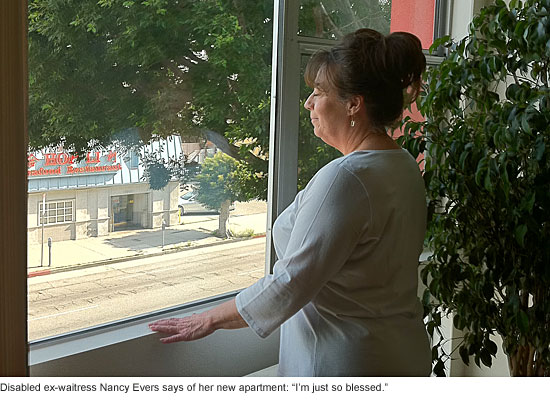 When Menorah Housing Foundation cut the ribbon this week on its bright new West Los Angeles senior housing project, Terri Tippit was thrilled.
When Menorah Housing Foundation cut the ribbon this week on its bright new West Los Angeles senior housing project, Terri Tippit was thrilled.
“That corner,” she says, “has been an eyesore for as long as I’ve lived here. And I’ve lived here for 37 years.”
Although the $10.9 million complex has been open for two months at Veteran Avenue and Pico Boulevard, this week marked its official grand opening. Restricted to tenants 62 and over with a maximum income of $29,000 for one-person households and $33,150 for couples, it brings 45 units of desperately needed low-income senior housing to one of the city’s priciest neighborhoods.
“We received 1,134 applications,” says foundation president Anne Friedrich, whose organization—a non-profit, non-sectarian offshoot of the Jewish Federation of Greater Los Angeles—operates 17 apartment buildings for low-income seniors throughout the county. “We held a public lottery.”
During the 1970s and 1980s, the building housed the Department of Public Social Services West Los Angeles Regional Office—a drab, beige, 37,597-square-foot welfare facility in an area of homes and apartments. All day, Tippit says, needy people would line up outside, waiting for caseworkers. Periodically, the office would reach capacity and close its doors, and the crowds would mill around the neighborhood, waiting for the building to reopen.
“It was all right at first, when it was mostly women and children,” says Tippit, who chairs the Westside Neighborhood Council and serves as president of the West of Westwood Homeowners Association. “But then it switched to more of a general relief, homeless population. There was a liquor store directly across the street—with a signal, yet—and, well, I won’t go into the gory details, but there were a lot of problems with the clients. They weren’t respectful of the community.”
Sympathetic though she was, she says, she and others pushed hard for the welfare offices to be moved to a more commercial sector. But when the move finally occurred, the now-vacant building presented new problems. Unoccupied for years, it became a magnet for weeds, graffiti and vagrants. “It wasn’t kept up,” she says. “You can’t have people sleeping in doorways.”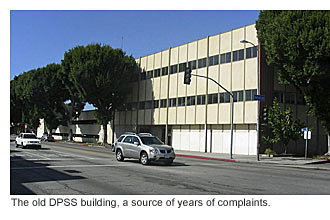
Finally, in 2009—and with city, county and federal assistance—Menorah Housing Foundation bought the property from Los Angeles County, razed the old offices and started construction on the new apartments. It wasn’t easy, says Lance Bocarsly, who chairs the foundation’s board. Because property values in Los Angeles are so high, low-income housing projects can be prohibitively expensive.
“Supervisor Yaroslavsky was absolutely instrumental in letting us pull this together,” says Bocarsly. “This would not have happened without him. He was the engine.” Which is why, he added, the new complex has been named the Zev Yaroslavsky Apartments.
Tippit says the neighbors are so happy that they’ve decided to be patient—for now—with an unexpected parking issue caused by the number of cars at the complex.
“Now that there’s a new building,” she says, “it’s a whole new environment.”
For the residents, the place is nothing less than a godsend. Clean and secure, with a bus stop out front, a diner next door and a shopping center a half-block walk away on a level sidewalk, the apartments rent on a sliding scale that averages about $240 a month. Friedrich says the average tenant is 71 and the average income is far below the eligibility requirement.
“I moved in here on my birthday, February 15, and it was the best present I’ve ever had in my life,” says 63-year-old Nancy Evers, a disabled ex-waitress who had been paying $785 a month for a room over a garage in Montrose when she heard she had won the right to lease her third-floor unit.
Evers said she had been trying for years to get into subsidized housing, only to be confronted with years-long waiting lists.
“I’m disabled and only get Social Security,” Evers says. “My rent only left me $50 a month to live on. I was living on bread. French toast, bread and butter, bread and bread. My doctor kept saying, ‘Nancy, what are you eating?’ But my daughter heard about Menorah Housing and said, ‘I think if you call, God is telling me it’ll be all right for you this time.’”
Evers was reluctant to get her hopes up.
“I’ve been working since the age of 13, when I got my first job peeling potatoes at a greasy spoon at Sixth and Bixel,” she says. “I never win anything. But I called and I got it. Now I have a one-bedroom apartment, and it’s so bright and sunny—full-sized fridge and stove, beautiful butter-yellow bedroom carpet. You could probably get four people in my shower. I’m just so blessed, and I think everyone in here feels the same way.”
Are our clean beaches endangered?
April 13, 2011
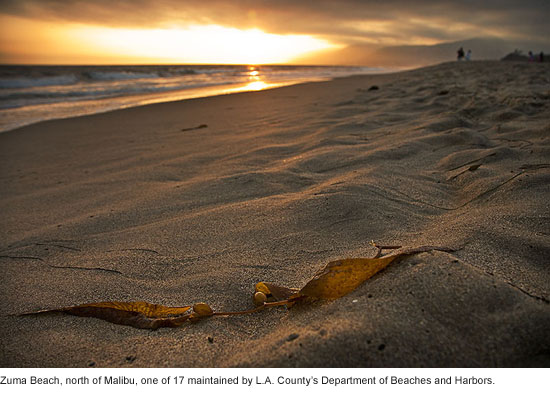 Spring may have just arrived but folks in the Department of Beaches and Harbors have already got summer on their mind.
Spring may have just arrived but folks in the Department of Beaches and Harbors have already got summer on their mind.
They’re scrambling to figure out how to maintain the county’s beaches and restrooms during the oncoming peak season after losing more than two dozen staffers who’d been hired with federal stimulus funds that are no longer available. At the same time, the department, like others in the county, cannot backfill for vacancies.
The impact, said LA County Department of Beaches and Harbors’ Chief Deputy Director Kerry Silverstrom, is unlikely to escape the public.
“We have an international reputation for clean beaches,” she said. “That will probably change.”
Beginning May 1, the Beaches and Harbors Department says it will consolidate last summer’s three overlapping shifts into just one, with the primary focus being to keep the beaches and restrooms clean during peak attendance. This means that, at some beaches, there’ll be no maintenance staff during early morning and evening hours.
With fewer workers, some previously performed maintenance will inevitably suffer, beach officials acknowledged. That includes large debris removal, weed abatement and even replacing damaged volleyball nets. But beach officials stressed that the financial situation is fluid and that they can’t say for sure exactly what services will be most impacted.
The Department of Beaches and Harbors—which maintains 17 beaches across 25 miles of coastline, with 52 bathrooms and 36 parking lots—first announced changes in bathroom service hours in a statement on Monday, saying “some restrooms may not be opened and serviced until as late as 11:00 a.m. year-round.”
Some news outlets followed up with stories in which they reported that bathrooms might be closed for days. This prompted irate phone calls from the public. The department responded on Facebook by saying that there will be no closures during the summer season and that the changes in hours would “allow limited staff to provide restroom cleaning later into the afternoon when beach usage is heaviest.”
Silverstrom said that both the frequency and intensity of cleanings would suffer because of the reduced numbers of maintenance workers, especially later in the day. Previously, all restrooms were opened by 6 a.m. But tentative plans now call for opening some at around 8 a.m. and others not until about 11 a.m.
Department officials said they do not yet know how many restrooms would be impacted but stressed that the most crowded would get the most attention. The use of portable toilets has been suggested but Silverstrom said she believes this could cause consternation among residents and beachgoers.
Aside from bathrooms, beachgoers will likely notice other issues stemming from the reduction in staff, including parking.
Maintenance staff has been responsible for opening and closing the lots in years prior. Now that they’ll be reporting 2 hours later to their shifts, Beaches and Harbors is trying to figure out how to still get the lots opened early and closed late. Some lots, including a dozen at Zuma Beach, will not be affected because early-arriving power equipment operators will open them. Officials are still determining how to get them locked up at night.
The department said it will also make sure that 5 lots identified as among the county’s most popular will also be opened at 6 a.m. Under one tentative plan, another 6 lots in relatively safe locations would be kept open around the clock. At least one lot, at Nicholas Beach, will open later in the day.
All these challenges are exacerbated, of course, by the consistently large draw of the county’s beaches. Last year was considered a “bad weather year” for LA County beaches. Still, Silverstrom estimates that 60 million visitors came to play in the sand and surf—10 million more than in 2008.
The department said it will continue to update the public through its Facebook and Twitter pages.
Posted 4/7/11
Bikes make tracks on Metro trains
April 13, 2011
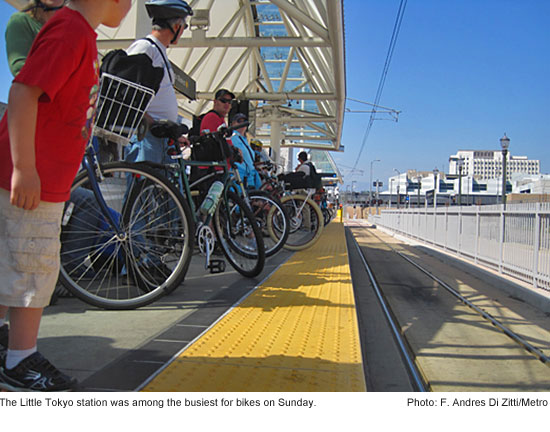 When Metro volunteers checked out the bike-toting crowds on downtown transit platforms Sunday morning, a thought straight out of “Jaws” leapt out at them:
When Metro volunteers checked out the bike-toting crowds on downtown transit platforms Sunday morning, a thought straight out of “Jaws” leapt out at them:
We’re gonna need a bigger train.
Sunday’s CicLAvia ride through Los Angeles streets was not just a test of the city’s ability to embrace a car-free existence for a few hours. It also was a test of Metro’s ability to cope with the largest congregation of bicycle commuters it’s ever faced, as thousands turned to public transportation to get them to and from the 7.5 mile route.
And—while it’s certain that many riders encountered delays, crowded train cars or both—it’s clear that the event was a milestone in the agency’s evolving track record of accommodating bicycles aboard its subway and light rail trains.
“I think it was a great opportunity to show that bikes and commuters and trains can all coexist,” said Andres Di Zitti, a Metro transportation planner who took part in the event as a volunteer and photographed some of the action. “This year, there were many more people and we were able to respond quickly…As we got to downtown, and saw the big turnout and the platforms starting to fill up, we called the operations managers and they sent longer trains out. It was definitely a good learning experience for us.”
Bruce Shelburne, a director in Metro operations, was on the receiving end of many of those phone calls. His staff was able to respond by quickly adding extra cars to trains on the Red, Purple and Gold lines—doubling capacity in some cases. They also had a couple of standby trains available, and those were pressed into service as well.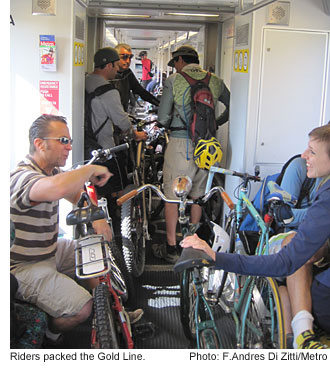
“We handled a pretty stressful day,” Shelburne said. “There’s no transit agency in the world that could have processed the amount of bikes that we had out there, period. I haven’t heard any complaints yet. I’m sure we’ll get some. But overall, it was a positive experience.”
Joe Linton, a longtime bike activist and one of CicLAvia’s organizers, said Metro did a good job of making more room for cyclists on its trains during the event. “I heard that some trains were very crowded—which is a good problem to have,” Linton said.
Sunday’s CicLAvia was the city’s second, and two more are in the works, tentatively scheduled for July 10 and October 9. Both will follow the same basic route, although a “spur” to the USC/Exposition Park area may be added, along with a Chinatown segment.
At the same time, Metro is considering plans to open up its trains for more bike commuters every day—not just CicLAvia Sundays.
Bikes currently are banned from Metro trains during peak commuting hours. That could change under a proposal set to go before Metro’s Operations Committee on April 21. The committee also will consider whether to spend $950,000 to remove some seats from light rail cars to make more room for bicycles. Seats already have been removed from Metro subway cars, Shelburne said.
Carving out more room for bikes and other items onboard the trains is a testament to changing commuting habits. “Back in 1990, the biggest thing we ever saw on a train was a briefcase,” Shelburne said. “Now everybody takes their life’s belongings with them.”
Accommodating cyclists by allowing them to ride the trains anytime could carry more than just symbolic value, according to a staff report urging reversal of the peak-hour ban.
“Elimination of time restrictions would allow unfettered access to the rail system,” the report said. “This would encourage more people to ride transit knowing that they would be allowed to begin and end their trips using bicycles; reduce their carbon footprints as more cars come off the road and increase MTA ridership leading to a more sustainable environment.”
Although CicLAvia was a special event, it offered insights into how bikes and trains can coexist better day in and day out, Shelburne said.
“Every time we do this event, we find some things that were done wrong,” Shelburne said. A biggie: “Passengers need to understand they cannot block doors on the trains. We have to probably provide a little more education.”
Get clean and green for Earth Day
April 13, 2011
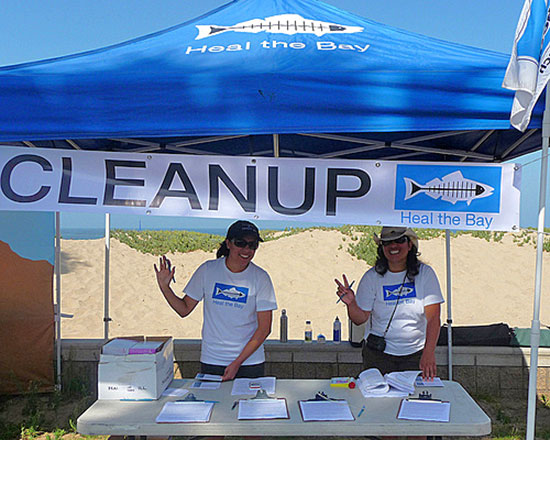 It’s time for spring cleaning—and not just in your attic. With Earth Day almost upon us, April is the perfect month to scrub, tidy and freshen up your local environment.
It’s time for spring cleaning—and not just in your attic. With Earth Day almost upon us, April is the perfect month to scrub, tidy and freshen up your local environment.
On a global level, Earth Day organizers this year have made “a billion acts of green” a theme of the observation. The object is to register a billion pledges toward a more sustainable planet in anticipation of the United Nations’ 2012 Earth Summit in Rio de Janeiro.
But locally, Southern California also has many ways to pitch in, from beach cleanups to e-waste recycling.
Here are just a few ways you can help make your backyard sparkle this spring:
–Get in on Heal the Bay’s “Nothin’ But Sand” beach cleanup day April 16 in Torrance and the Pacific Palisades. Volunteers will get a free reusable water bottle, while supplies last, and—this weekend—a free pass to the Santa Monica Pier Aquarium. (Don’t forget to sign their waiver form.)
–Got an old mattress or porch sofa in need of disposal? The Los Angeles County Department of Public Works suggests that you get rid of it responsibly—during one of the county’s many bulky item clean-up days.
–And don’t forget to do the same with your old electronic equipment. Cal State Northridge is sponsoring a big e-waste recycling event on April 22 as part of its Earth Day observation, and DPW has an ongoing collection schedule that will take e-waste off your hands.
–Join the Friends of the Los Angeles River for The Great L.A. River Cleanup, happening at more than a dozen sites along L.A.’s favorite waterway on April 30 from 9 a.m. until noon.
–Looking for something a little livelier? Earth Day celebrations abound this month. Pasadena has one this weekend. So does South L.A. So does CSUN, which, among other things, invites you to come pick oranges on Sunday morning for a local community food program. Topanga’s will open with yoga and close with a drum circle April 22-24.
–Or go really big and check out the Go Green Expo at the Los Angeles Convention Center this weekend. They’ll have kids’ activities, booths, eco-celebrities such as Ed Begley Jr., Mariel Hemingway and Captain Paul Watson of Animal Planet’s “Whale Wars”.
Posted 4/13/11
Dispatches from a democracy in progress
April 11, 2011
 Election day, Saturday, started ominously. The night before, a terrorist bomb exploded in the city of Suleja, 12 miles from the nation’s capital, Abuja. At least 13 people were killed. There were several other incidents Friday night that were obviously designed to disrupt the election. It didn’t work.
Election day, Saturday, started ominously. The night before, a terrorist bomb exploded in the city of Suleja, 12 miles from the nation’s capital, Abuja. At least 13 people were killed. There were several other incidents Friday night that were obviously designed to disrupt the election. It didn’t work.
The election appeared to be an improvement over previous national elections here. To be sure, there were problems. It took hours in the a.m. for people to check in, and then several more hours in the p.m. for voters to cast their ballots. All voting was outdoors, and it was hot and humid. I was wiped out, and I had an air conditioned car to which to escape. I can’t imagine what women with babies on their backs were going through, standing for hours at a time. These waits created some episodic tension.
Other problems our delegation witnessed included under age voting, missing names on voter registration rolls, late opening of many polling sites, inconsistency in the posting of the results at polling stations, inconsistency in the application of election laws and rules, and a lack of prioritization for the elderly, disabled and pregnant women or other women who brought their youngsters to voting stations. All these concerns were addressed in a preliminary report released by our NDI delegation.
Nevertheless, we thought that Nigeria took a positive and necessary step toward the building of a sustainable democracy and strong democratic institutions. Voters came by the hundreds to each polling station, determined to make this election work. Many hung around all day in the oppressive weather and into the dark evening to observe the vote count.
An especially moving part of election day came at the end, when ballots were tabulated at polling stations. We chose one at random to monitor in the central part of Ilorin, the capital of Kwara state, where we were deployed. A crowd of nearly 100 partisans of various parties gathered to observe the count at this precinct, a scene repeated at thousands of polling places around the country.
 Afer each ballot was retrieved from the ballot box, the precinct officer would show it to the assembled crowd and announce the chosen candidate. Cheers would arise from the partisans in the crowd. When the vote’s final result was announced, the winning side not only cheered but started dancing in the street. It was an exhilarating end to a very long day. The results were then posted (at our polling station, at least), and the ballots were transported to the election commission headquarters for the official election report.
Afer each ballot was retrieved from the ballot box, the precinct officer would show it to the assembled crowd and announce the chosen candidate. Cheers would arise from the partisans in the crowd. When the vote’s final result was announced, the winning side not only cheered but started dancing in the street. It was an exhilarating end to a very long day. The results were then posted (at our polling station, at least), and the ballots were transported to the election commission headquarters for the official election report.
As we concluded our election day activities, I asked my observation partner, Jennifer Cooke, director of the Africa program for the Center for Strategic and International Studies, what are the American national security interests in Africa. She said that the three principal interests are:
1. Corrupt regimes and/or political instability are fertile breeding grounds for extreme ideologies and movements that manifest themselves in ways that are inimical to our interests.
2. Energy. Nearly 25% of our imported oil now comes from Africa, 9% of it from Nigeria itself. Political stability is, therefore, in our best interest. Instability can cause the price of energy to fluctuate and supplies to diminish. And energy uncertainty has its own national security issues for us.
3. In the increasingly globalized nature of our economy and other national policies, we will increasingly depend on coalitions with and support of the many nations on this African continent to join with us in various international forums as we address issues such as trade and terrorism.
Simply put, Nigeria is the biggest nation on the African continent. Any failures there could easily spread to the rest of West Africa and beyond. This would not be good for them or for us. To paraphrase the late German statesman Klemens von Metternich, if Nigeria sneezes, the rest of Africa could well catch a cold.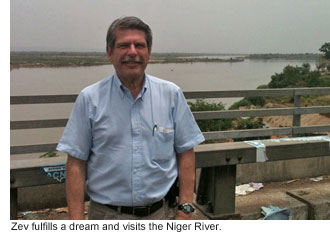
So our election monitoring delegation leaves Nigeria tonight with the satisfaction that this country got a lot right in its election, but tempered by the reality that it has a long way to go.
On a personal note, I did get my chance to see the Niger River today, a body of water that has intrigued me since my days as a graduate student at UCLA in British Imperial history. We drove back to Abuja, an eight hour drive of 300 miles. The roads are, to be blunt, horrible—two lanes all the way, with missing chunks of road every now and then that makes driving them time consuming and dangerous. Overturned trucks, including huge gasoline trucks, abound along the roadsides, crashed and abandoned by their drivers. As one local described it: ”Driving in Nigeria is a competition among drivers. Some win, and some don’t.”
About six hours into the drive we approached the bridge over the Niger. I asked our driver to stop so I could take a closer look and give me and the river a chance for our photo op. I never thought I’d have this chance, and yet here I was.
To those of you who have been following my blogs from Nigeria, thank you. I’ve enjoyed sharing this experience—both the policy and personal sides. As I prepare for my 22 hour trip home, I confess that I’ll be sorry to leave. The people have been wonderful, and I won’t soon forget their courage and resilience. I wish them well on their march toward sustainable democracy, a march that all of us should support, not only because it’s in our best interests, but because it’s right.
Photos from Zev Yaroslavsky
Posted 4/11/11







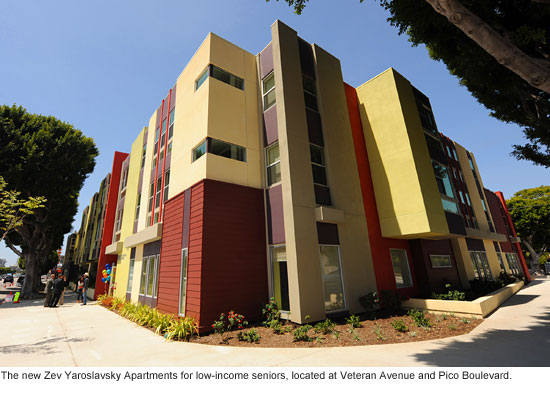
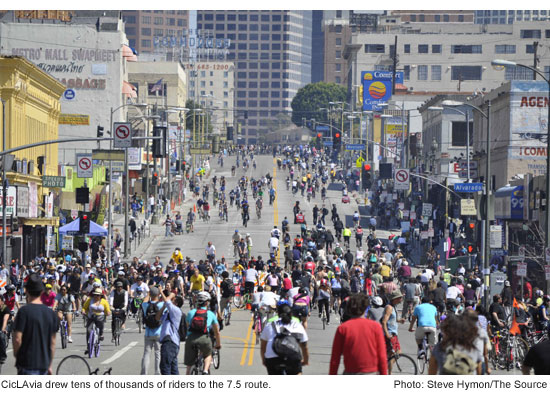

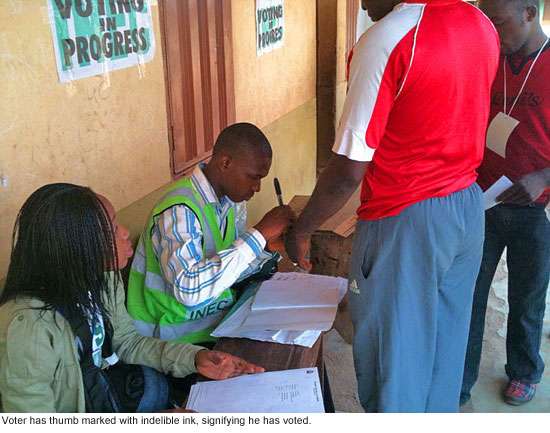





 Check for the latest closure information
Check for the latest closure information








